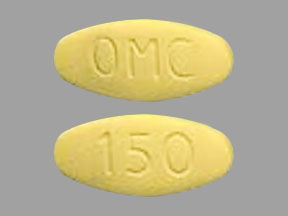Omadacycline Dosage
Medically reviewed by Drugs.com. Last updated on Aug 18, 2025.
Applies to the following strengths: 100 mg; 150 mg
Usual Adult Dose for:
Additional dosage information:
Usual Adult Dose for Pneumonia
Loading Dose:
- IV: 200 mg via IV infusion (over 60 minutes) on day 1 OR 100 mg via IV infusion (over 30 minutes) twice on day 1 OR
- Oral: 300 mg orally twice on day 1
Maintenance Dose:
- IV: 100 mg via IV infusion (over 30 minutes) once a day OR
- Oral: 300 mg orally once a day
Duration of Therapy: 7 to 14 days
Use: For the treatment of patients with community-acquired bacterial pneumonia due to the following susceptible microorganisms: Streptococcus pneumoniae, Staphylococcus aureus (methicillin-susceptible isolates), Haemophilus influenzae, H parainfluenzae, Klebsiella pneumoniae, Legionella pneumophila, Mycoplasma pneumoniae, Chlamydophila pneumoniae
Usual Adult Dose for Skin and Structure Infection
Loading Dose:
- IV: 200 mg via IV infusion (over 60 minutes) on day 1 OR 100 mg via IV infusion (over 30 minutes) twice on day 1 OR
- Oral: 450 mg orally once a day on day 1 and day 2
Maintenance Dose:
- IV: 100 mg via IV infusion (over 30 minutes) once a day OR
- Oral: 300 mg orally once a day
Duration of Therapy: 7 to 14 days
Use: For the treatment of patients with acute bacterial skin and skin structure infections due to the following susceptible microorganisms: S aureus (methicillin-susceptible and -resistant isolates), S lugdunensis, S pyogenes, S anginosus group (includes S anginosus, S intermedius, and S constellatus), Enterococcus faecalis, Enterobacter cloacae, K pneumoniae
Renal Dose Adjustments
Mild, moderate, or severe liver dysfunction: No adjustment recommended.
Liver Dose Adjustments
Mild, moderate, or severe liver dysfunction (Child-Pugh A, B, or C): No adjustment recommended.
Precautions
CONTRAINDICATIONS:
Known hypersensitivity to the active component, tetracycline-class antibacterial agents, or any of the ingredients
Safety and efficacy have not been established in patients younger than 18 years; this drug is not recommended for use in patients younger than 8 years.
Consult WARNINGS section for additional precautions.
Dialysis
ESRD receiving hemodialysis: No adjustment recommended.
Other Comments
Administration advice:
IV:
- After reconstitution and dilution, administer via IV infusion (total infusion time: 60 minutes for 200 mg dose or 30 minutes for 100 mg dose); administer through a dedicated line or through a Y-site.
- If the same IV line is used for sequential infusion of several drugs, flush the line before and after infusion of this drug with 0.9% Sodium Chloride Injection, USP or 5% Dextrose Injection, USP.
- Do not administer with any solution containing multivalent cations (e.g., calcium, magnesium) through the same IV line; co-infusion with other agents has not been studied.
- Fast for at least 4 hours and then take with water; after oral dosing, do not consume food or drink (except water) for 2 hours and do not consume dairy products, antacids, or multivitamins for 4 hours.
Storage requirements:
- Lyophilized powder and tablets: Store at 20C to 25C (68F to 77F); excursions permitted to 15C to 30C (59F to 86F); do not freeze.
- Diluted infusion solution: May be used within 24 hours at room temperature (up to 25C [77F]) or within 7 days when refrigerated at 2C to 8C (36F to 46F); do not freeze; allow infusion bag to reach room temperature before use.
Reconstitution/preparation techniques:
- IV: This drug must be reconstituted and then further diluted (within 1 hour); the manufacturer product information should be consulted.
IV compatibility:
- Compatible IV solutions: 0.9% Sodium Chloride Injection, USP; 5% Dextrose Injection, USP
- Compatibility with other drugs and infusion solutions not established.
General:
- To reduce the development of drug-resistant organisms and maintain effective therapy, this drug should be used only to treat or prevent infections proven or strongly suspected to be caused by susceptible bacteria.
- Culture and susceptibility information should be considered when selecting/modifying antibacterial therapy or, if no data are available, local epidemiology and susceptibility patterns may be considered when selecting empiric therapy.
Patient advice:
- Avoid missing doses and complete the entire course of therapy.
- Fast for 4 hours before and 2 hours after taking the tablets; do not consume dairy products, antacids, or multivitamins for 4 hours after taking the tablets.
- Notify healthcare provider immediately if you become pregnant during therapy.
- Contact physician as soon as possible if watery or bloody stools (with or without stomach cramps and fever) develop.
Frequently asked questions
More about omadacycline
- Check interactions
- Compare alternatives
- Side effects
- During pregnancy
- Drug class: tetracyclines
- Breastfeeding
- En español
Patient resources
- Omadacycline oral/injection drug information
- Omadacycline (Intravenous) (Advanced Reading)
- Omadacycline (Oral) (Advanced Reading)
- Omadacycline Tablets
Other brands
Professional resources
Other brands
Related treatment guides
See also:
Further information
Always consult your healthcare provider to ensure the information displayed on this page applies to your personal circumstances.


